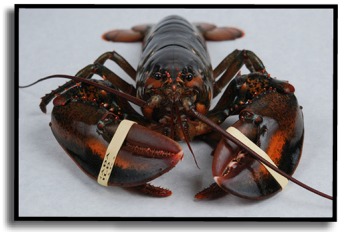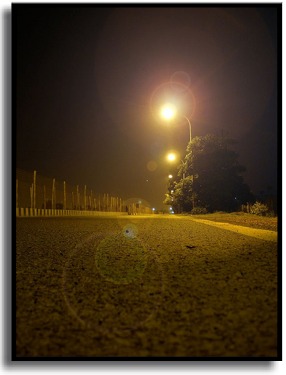Posted by Nicky Drayden on Apr 30, 2010 in
Reviews Author Website: http://www.alexdallymacfarlane.com
Published by: Fantasy Magazine, March 2010
 Photo by Paula Ouder, courtesy LSGCP Creative Commons
Photo by Paula Ouder, courtesy LSGCP Creative Commons
The Story:
A British newspaper columnist named Sasha travels across the country, hoping to snag an interesting story on a curious city whose entire industry revolves around lobster. Tourists flock in droves during the summer, delighting in succulent whole lobster, curried lobster, lobster pasta, grilled, on a bun, or with veggies. The recipes seem endless, but the summer is not. No one knows what goes on in the city in the winter months, when the tourists leave and the city’s gates shut behind them.
The Craft: World Building
SPOILERS
The classic fish out of water (lobster out of water?) point of view is a great way to introduce the details of a world without being artificial. We get to see The City of Lobster through Sasha’s eyes and experience its wonders from a fresh perspective. Sasha arrives and takes the city in, smells the salt air, walks along the seafront, sees a woman dressed as a lobster welcoming people back to the city. It’s unremarkable to Sasha in the beginning, not quite living up to her expectations of this wonderfully weird place. But as she settles in, she learns more about the city’s history and legends, like how during a festival that happens once every five years, the entire city dresses up like lobsters. There’s also a tale of a lobster-maid — half lobster, half woman — who leaves her home in the sea on an occasion so rare, it won’t happen twice in any person’s lifetime. Legends and history are not only interesting tidbits for the reader, but also help bring the city to life, cementing it in a timeline that exists beyond the story itself.
After a conversation with the woman dressed as a lobster, Sasha begins to wonder about how the city’s inhabitants live after the tourists have gone. She herself grows tired of eating lobster and seeks out other meats: chicken, crab, mussel. Unfortunately, one of those delectable morsels sends her stomach churning, making her so ill she requires hospitalization. The city’s gates close while she’s still hooked up to IVs. When she’s well enough to venture out, she sees that all traces of lobster have been scrubbed from the town. Sasha stumbles upon a festival on Anchorage Street with people dressed in all manners of costume, not a single one of them a lobster.
Sasha faces a delima on how to present her article. Clearly these people value their privacy, keeping their lives outside of tourist season a secret. For those summer months, everything goes into maintaining that facade so that they have the resources to be themselves for the rest of the year. But if she doesn’t report all that she’s learned, her article will be nothing more than a half-truth. The city wears two skins, Sasha decides, leaving vague hints in her article for those who dare to see them, and perhaps seek the truth for themselves. And as readers, we’ve seen a glimspe of these two skins and the mysteries that live between them — opposite sides of a coin, but both rich and full of delicious details.
Tags: Fantasy Mag, world building
Posted by Nicky Drayden on Apr 17, 2010 in
Reviews Author Website: www.jlake.com
Published by: Clarkesworld Magazine, February 2010
 Photo by Rick Creative Commons
Photo by Rick Creative Commons
The Story:
Engineering Supervisor Domitian Spanich is always falling for the wrong type of guy — the young, pretty kind who don’t stick around once they’ve spent his pay chitty on fancy drinks. Half the guys torquing vacuum on Estacada Orbital swing his way, and yet Spanich finds himself hopelessly captivated by Austen, Spanich’s dull-witted sometimes lover, whose finer attributes include a tight body, crooked smile, and violet eyes. But then Austen shows unexpected interest in Mare Imbrium {13 pairs}, the starship Spanich had been working on for three straight shifts, and Spanich’s world changes overnight.
The Craft: World Building
SPOILERS
Torquing Vacuum has a lot going on world building wise, and yet it’s all integrated into the story in a way that doesn’t leave the reader’s head spinning. (Though I do admit, I had to print this one out so I could better digest it.) Immediately the world feels foreign, right from the mention of Spanich’s name (pronounced Span-ick, or Spinach if you really want to piss him off.) We quickly learn that Spanich is a drive tech on Estacada Orbital. He’s working on a ship, the Mare Imbrium {13 pairs}, which has a shipmind — a bit of world building that really stands out in this piece. Here, the shipminds aren’t subservient as they are in so many science fiction stories, but revered and their ship’s names demand respect, like the credentials of a honored official.
The ambiance of Estacada Orbital is set with a mix of tech and culture, introduced with conflicts related to the story. We learn of the monetary system through Austen’s frivolous spending of Spanich’s pay chitty, local thalers, and Imperial schillings, the latter of which also hints at the greater political structure of this universe. The cybernetic waiter at the bar seems like it’s just as likely to kill Spanich as it is to serve him a drink, which suggests that Estacada Orbital is the kind of place where you watch your back. The colloquialisms also add a touch of charm, like: “Thank the pressure demons this place was so dark.” and I particularly enjoyed the line about how “Austen could scent ‘broke’ the way a sniffer could find a carbon dioxide breach in a scrubber tank.”
We’re also given a broader view of the universe with mentions of the Mistake, an event that is never explained, but its effects weigh heavily on the story in the form of genetically altered humans. The glimpse of the Imperial family is a small one, but is also very telling. Watching Spanich’s reaction as he realizes who Austen really is gives us insight into the hierarchy and ruling class, though their interaction is of a personal nature rather than political. Overall, this story gives the reader a lot to chew on, but it’s presented in manageable chunks. The details of the world are specific and fun and are worked into the story in a natural, tidy, entertaining way.
Tags: Clarkesworld, queer fiction, science fiction, space opera, world building
Posted by Nicky Drayden on Apr 12, 2010 in
Reviews Published by: Chizine, 2010
 Photo by Dipanker Dutta Creative Commons
Photo by Dipanker Dutta Creative Commons
The Story:
There was a time, not long ago, when humans ruled the Earth. But all that’s disappeared, along with those people who didn’t accept their new lot in life and went out looking for answers, never to be seen again. The night rules now, and the dark will get you if you aren’t careful. The night never comes into houses though, so people huddle together, cramming into living rooms, bedrooms, wherever there’s space. Windows are papered shut so the darkness won’t seep inside. There’s some semblance of safety in the light, and for two young women, the thrill of venturing out past curfew, jumping between the pools of yellow light cast by streetlamps is too much to resist.
The Craft: World Building
SPOILERS
The Year of the Rabbit is an interesting example of world building, because the world is not built with description but with fear and the characters’ reaction to fear. The story starts with streetlamps, or more importantly, the light they emit at night, keeping the dark away. We quickly learn that the night is not safe. The reader doesn’t get a clear sense of what’s going on in the opening scene, but we do know that we should be afraid. The word cues are subtle, but there: “drowning in the dark”, “lights started dying”, “illusion of safety”, “swarming ocean of black”. It’s clear these characters have diverged from our world and have journeyed into one of their own.
In the next few scenes, we get a sense of what life is like for these people now that humanity has been thrown from the driver’s seat. No longer in control, they hide from the night, drawing strength in numbers, and using each other for warmth in the winter months. The electricity and water are gone, but they make do. And curiously, there’s always food waiting for them, though no one tends the store. No one asks where the food is coming from. Curiosity is what’ll get you snatched up by the night, like all those others who went searching for answers and never came back. There’s something otherworldly going on here, and just when the reader is starting to get uncomfortable, the author strikes at our childhood fears:
“Night never came into the houses. It was the same way that kids’ monsters never crawled under their blankets and never reached over the side of their beds.”
The world expands some in the following scenes, and we get a glimpse of the park and the city and the streets. The park is so full of light, that even the shadows look friendly, but by now, the reader knows better. The city has been picked clean, wooden garages torn down for firewood, abandoned houses scavenged for blankets and food. And the streets are dark and too quiet, with streetlamps flickering in and out like the dark is trying to catch you.
Year of the Rabbit tempts the reader to dangle her feet into the mysterious shadows, and the thrill of the story is well worth it. Wonderfully written, intriguing, and poignant, this story will take you to another world constructed from the fear within.
Tags: Chizine, dark, literary, world building
 Photo by Paula Ouder, courtesy LSGCP Creative Commons
Photo by Paula Ouder, courtesy LSGCP Creative Commons 

